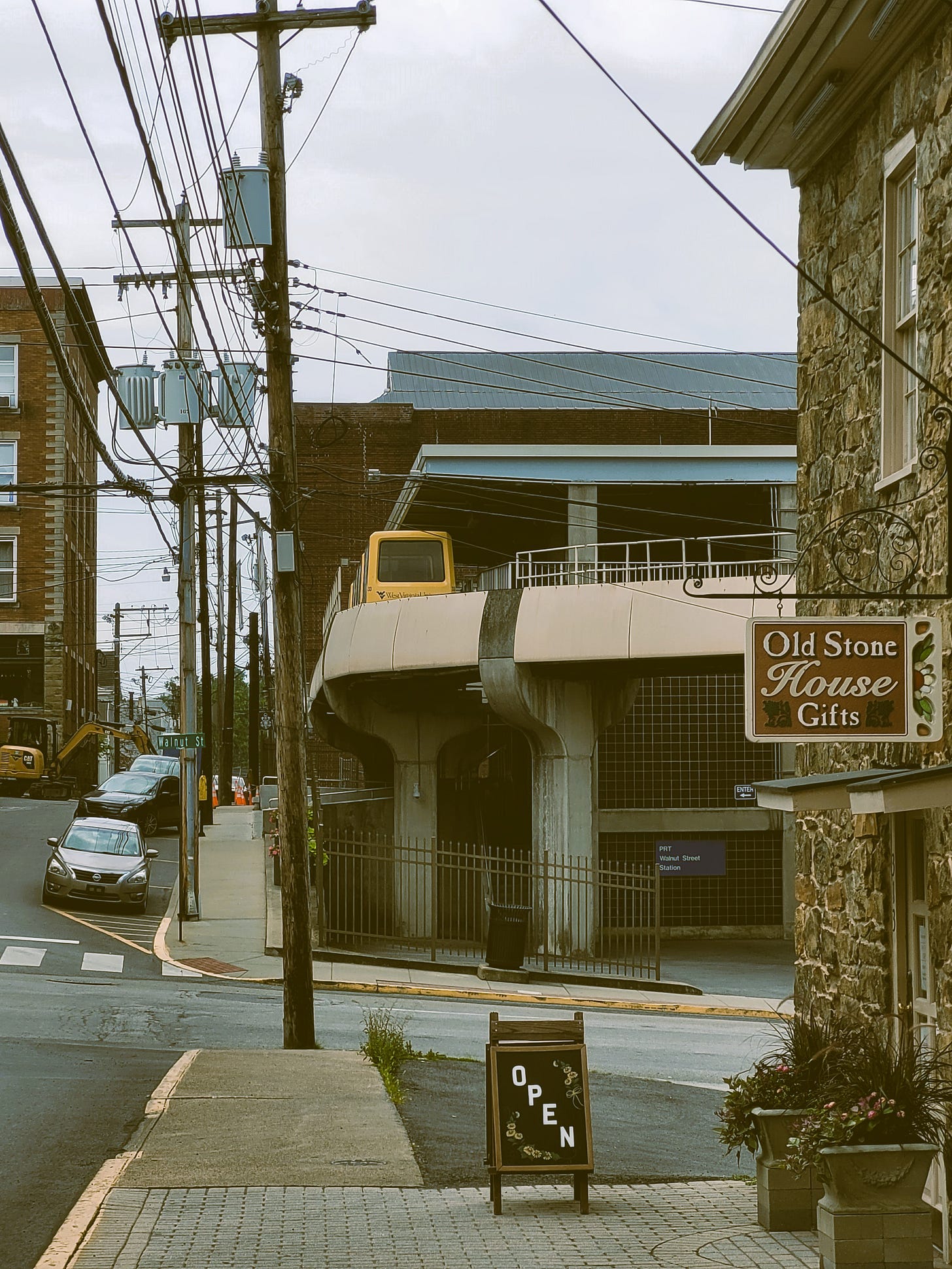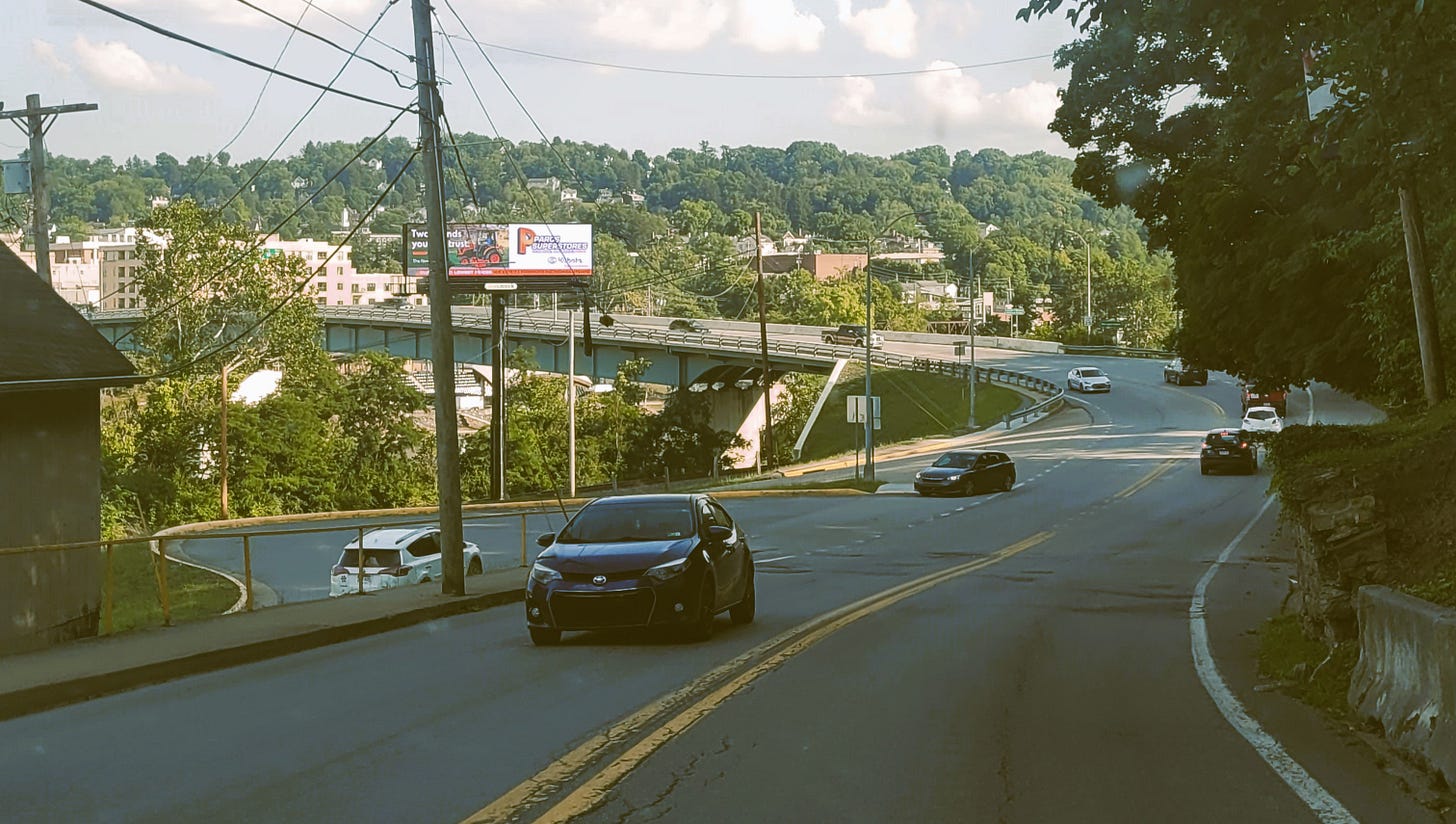Under the Monorail
Public transportation in the mountains of West Virginia
I was standing under a monorail in West Virginia. It took several minutes for me to process this information. Here I was, walking down the street looking for a bite to eat. I looked up and saw train tracks. It seemed like a strange place for elevated rail, so I followed the tracks out of curiosity. Sure enough, there it was: a monorail. In West Virginia.
You don’t see monorails very often in North America. When you do, it’s usually at an airport or a theme park. I certainly didn’t expect to see one in a town of 30,000 tucked away in the mountains of West Virginia.
It’s a surreal scene. The tracks sit against the thick West Virginia foliage like a relic from an abandoned civilization, reclaimed by nature. No one from our epoch would build this, after all. Or so I would have thought.
Unfortunately, it was closed for the season (we’ll get to that later). So while I have visual evidence that it exists, I’ve yet to see it operate. Maybe it is just a relic. Civilizations come and go, after all.
I decided to do some research. So I popped in to Morgantown Brewing Company to have a beer and tuck into my phone. Instead, I got into a wide ranging conversation with one of the bartenders about the monorail, Morgantown, and West Virginia.1
To understand the monorail, you have two know two things. First, Morgantown is in a mountain valley on the banks of the Monongahela River. It’s difficult terrain. There are only so many roads you can build, and bridges aren’t cheap. Second, Morgantown is home to West Virginia University, which hosts around 25,000 students. Small town, large university, inhospitable terrain. That doesn’t leave a lot of options for moving people around.
That’s where the monorail comes in. Moving 25,000 students around a small mountain town is challenging. As the story goes, the University used to rely on vans to shuttle students about. Traffic congestion became a huge problem. An engineering professor, Samy Elias, had an idea: a Personal Rapid Transit (PRT) system.2
Then, like now, West Virginia had an influential Senator, Robert Byrd. West Virginia University managed to secure a grant for the system. President Richard Nixon took a personal interest in the project, viewing it as a potential breakthrough in urban transportation. The administration called for the project to be up and running in time for the 1972 election. That did not happen. The Morgantown Personal Rapid Transit system opened in 1975, a year after Nixon was impeached.
Not only did the PRT not help Richard Nixon win re-election - though he won anyways, only to be impeached two years later - it did not revolutionize public transposition. But there is a lesson here: sometimes seemingly ridiculous ideas work.
Context is crucial in public policy. Unique challenges often require bespoke solutions. Morgantown doesn’t have the luxury of endless sprawl. Having an automated monorail to move students, faculty, and staff between two campuses, two miles apart, seems to make sense for the city. It would be impractical most places. But it seems to work for Morgantown.
Unfortunately, I didn’t get to ride the PRT since it is only open during the school year. The system is run by the University, largely for students. The vast majority of locals drive. There’s another lesson here: public transit can benefit not only riders, but drivers. The PRT carries 15,000 people a day. That’s 15,000 fewer people sitting in traffic in a town of about 60,000 when class is in session. It may seem fanciful, but the PRT plays a vital role in the city. Sometimes weird solutions work.
I’m not suggesting that other cities should rush out and buy their own shiny new monorails. It’s possible it could work other places that have severe geographical constraints but need to move thousands of people between a few fixed points at specific times of the day for part of the year. But it’s a good reminder that sometimes we need to think outside the box.
Conventional places usually require conventional solutions. Morgantown is far from conventional. Hopefully the next time I pass through I get to ride the PRT - if for no other reason than to prove to myself that I wasn’t just hallucinating.
I remembered to write this long overdue piece today because I thought of that conversation when I heard the news about Senator Manchin retiring.
For more details, see this excellent history of Personal Rapid Transit: https://www.theverge.com/2016/2/24/11094524/prt-transit-history-self-driving-cars-alden-starrcar-tomorrowland-1960s














Was not expecting the Morgantown PRT to enter the chat today. But I’ve thought about trying to make it down that way the next time I wind up in Pittsburgh. That region of the world has some incredible urban bones.